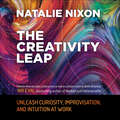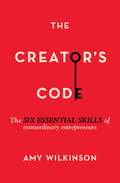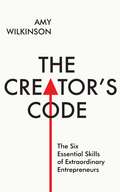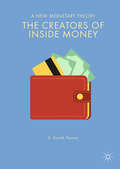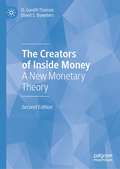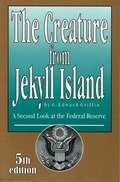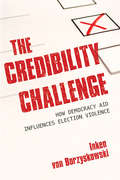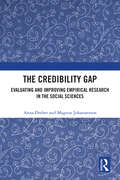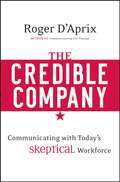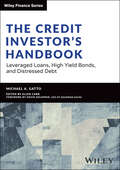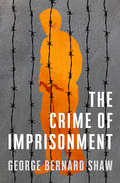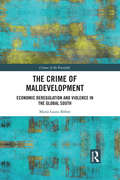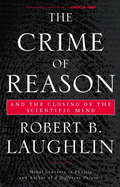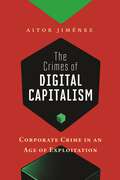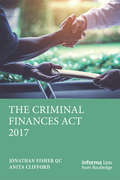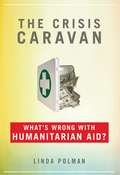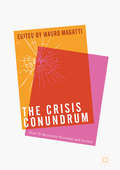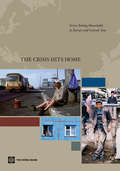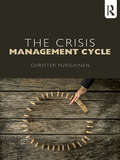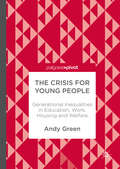- Table View
- List View
The Creativity Leap: Unleash Curiosity, Improvisation, and Intuition at Work
by Natalie Nixon"Natalie Nixon's new book provides a fresh primer on how to cultivate creativity in the workplace.&” —Nir Eyal, bestselling author of Hooked and IndistractableToo many people associate creativity solely with the arts, even though to be an incredible scientist, engineer, or entrepreneur requires immense creativity. And it's the key to developing breakthrough products and services. Natalie Nixon, a creativity strategist with a background in cultural anthropology, fashion, and service design, says that in the fourth industrial revolution a creativity leap is needed to bridge the gap that exists between the churn of work and the highly sought-after prize called innovation.Nixon says that since humans are hardwired to be creative, it is a competency anyone can develop. She shows that it balances wonder (awe, audacity, and curiosity) with rigor (discipline, skill-building, and attention to detail), and that inquiry, improvisation, and intuitionare the key practices that increase those capacities. Drawing on interviews with fifty-six people from diverse backgrounds—farming, law, plumbing, architecture, perfumery, medicine, education, technology, and more—she offers illuminating examples of how creativity manifests in every kind of work. Combining creativity tools and techniques with real-world stories of innovative people and businesses, this book is a provocation, an inspiration, and an invitation to unleash the innate creativity that lies within each of us. It offers a more dynamic and integrative way to adapt and innovate, one that allows us the freedom to access our full human selves.
The Creator's Code
by Amy WilkinsonEach of us has the capacity to spot opportunities, invent products, and build businesses--even $100 million businesses.How do some people turn ideas into enterprises that endure? Why do some people succeed when so many others fail? The Creator's Code unlocks the six essential skills that turn small notions into big companies. This landmark book is based on 200 interviews with today's leading entrepreneurs including the founders of LinkedIn, Chipotle, eBay, Under Armour, Tesla Motors, SpaceX, Spanx, Airbnb, PayPal, Jetblue, Gilt Groupe, Theranos, and Dropbox. Over the course of five years, Amy Wilkinson conducted rigorous interviews and analyzed research across many different fields. From the creators of the companies ranging from Yelp to Chobani to Zipcar, she found that entrepreneurial success works in much the same way. Creators are not born with an innate ability to conceive and build $100 million enterprises. They work at it. They all share fundamental skills that can be learned, practiced, and passed on. The Creator's Code reveals six skills that make creators of all kinds of endeavors breakthrough. These skills aren't rare gifts or slim chance talents. Entrepreneurship, Wilkinson demonstrates, is accessible to everyone. The book's insights provide core guidance for success in the new world of work.
The Creator's Code
by Amy WilkinsonKevin Plank was relatively small for an American footballer, and when he weighed the cotton T-shirt he wore under his team uniform, he found it weighed three pounds because it was so drenched in sweat. Knowing he couldn't hinder himself in this way, he set about finding a material that wasn't so absorbent. Going to a local fabric shop, he soon learned that synthetic materials would not take in as much sweat, so he had a shirt made and found it added just four ounces over the course of a game. When he gave some team-mates samples to try, they also soon saw the advantages. He began to produce the shirts commercially, and now Under Armour is a $2 billion global brand used by people from every sport. Packed with fascinating and inspirational tales of success, Amy Wilkinson's brilliant book explains the six essential skills required by entrepreneurs to achieve their dreams. Based on in-depth interviews with the founders of numerous global brands, from eBay to Spanx, from LinkedIn to PayPal, she shows just what they did and what set them apart. For the key to being a successful entrepreneur isn't necessarily about being 'first', it is about being the 'only' one, and devising a new formula where none previously existed. Above all, these stories show how - if you follow the right steps - anyone can become a successful entrepreneur.
The Creators of Inside Money: A New Monetary Theory
by D. Gareth ThomasThe book explores the endogenous creators of inside money, the commercial banks, and their key role in igniting the 2007-8 monetary crisis and the aftermath of the Great Recession. This is an area of study overlooked by the traditional approach in the form of neo-classical analysis, a body of theory based on a barter system of exchange. Money has evolved from a construct of barter to become a medium of exchange based on fiat money and loan creation by the banking system, underpinned by legal tender, and therefore, a creature of law. It is not a phenomenon exogenously controlled by the monetary authorities and simply assumed to be a “veil” over the real economy, which just determines the absolute price level. This monograph, in the eyes of the student, represents critical thinking and the realization of a more precise formulation of the endogenous money supply with various features systematically added in an attempt to derive a fully dynamic model of the monetary system, which will be straightforward to visualize and contrast with the benchmark approach.
The Creators of Inside Money: A New Monetary Theory
by D. Gareth Thomas David S. BywatersThis second edition updates and extends the original foundations of the loanable funds model. It develops a new monetary model of inside money, which is created by the commercial (or retail) banks, drawing on the events of 2007/08 that led to the Great Recession and fragile economy of today. Coronavirus is likely to cause another downturn of economic activity, from the perspective of late 2020 as this is written. That will represent a long-period of subpar, anaemic growth, which has not been satisfactorily explained by the traditional theory in the form of neo-classical analysis. The reason may lie with the adoption of a body of theory based primarily on a barter system of exchange but sometimes with one commodity used as money to try to explain a dynamic, monetary economy of today. Money has evolved from a system of barter to become a medium of exchange based on fiat money and credit currency underpinned by legal tender, and therefore, a creature of law. If households and firms lose confidence in the banking system, they can withdraw their deposits in the form of cash as a medium of exchange, which must be accepted in exchange for goods and services as legal tender. This book highlights the importance of how money is created or destroyed endogenously and derives the loanable supply of funds in conjunction with the demand within a revised analysis of monetary theory, with a new emphasis on portfolio theory. It applies critical thinking and the realization of a more precise formulation of the loanable funds theory to final year and postgraduate students in particular, with various features systematically added such as the catastrophe framework and Minsky’s theory of changing states in an attempt to derive a fully dynamic model. There is a new framework using aggregate demand and supply analysis to explain inflation. This will be reinforced at each stage by the inclusion of revised and updated case studies, graphs and figures to give an international setting and application
The Creature from Jekyll Island: A Second Look at the Federal Reserve
by G. Edward Griffin<p>This is the classic exposé of the Fed that has become one of the best-selling books in its category of all time. Where does money come from? Where does it go? Who makes it? The money magician's secrets are unveiled. Here is a close look at their mirrors and smoke machines, the pulleys, cogs, and wheels that create the grand illusion called money. A boring subject? Just wait. You'll be hooked in five minutes. It reads like a detective story - which it really is, but it's all true. <p>This book is about the most blatant scam of history. It's all here: the cause of wars, boom-bust cycles, inflation, depression, prosperity. Your world view will definitely change. Putting it quite simply, this may be the most important book on world affairs you will ever read. The 5th Edition includes a no-holds barred analysis of bank bailouts that are shown to be nothing less than legalized plunder of the people. Many other updates have been added, including a revision to the list of those who attended the historic meeting at Jekyll Island where the Federal Reserve was created.</p>
The Credibility Challenge: How Democracy Aid Influences Election Violence
by Inken von BorzyskowskiThe key to the impact of international election support is credibility; credible elections are less likely to turn violent. So argues Inken von Borzyskowski in The Credibility Challenge, in which she provides an explanation of why and when election support can increase or reduce violence. Von Borzyskowski answers four major questions: Under what circumstances can election support influence election violence? How can election support shape the incentives of domestic actors to engage in or abstain from violence? Does support help reduce violence or increase it? And, which type of support—observation or technical assistance—is better in each instance? The Credibility Challenge pulls broad quantitative evidence and qualitative observations from Guyana, Liberia, Kenya, Sierra Leone, and Bangladesh to respond to these questions. Von Borzyskowski finds that international democracy aid matters for election credibility and violence; outside observers can exacerbate postelection violence if they cast doubt on election credibility; and technical assistance helps build electoral institutions, improves election credibility, and reduces violence. Her results advance research and policy on peacebuilding and democracy promotion in new and surprising ways.
The Credibility Gap: Evaluating and Improving Empirical Research in the Social Sciences
by Anna Dreber Magnus JohannessonWhich scientific results can we trust? This question has been brought to the forefront of research in the social sciences in recent years with the movement towards open science practices and preregistration. Systematic replication studies of laboratory experiments in the social sciences have found that only about half of the “statistically significant” results published in top journals can be replicated in the sense that similar results are achieved with new data. This low replicability may be even lower in studies based on observational data as such studies have more degrees of freedom in the analysis of the data leading to larger possibilities to selectively report more publishable findings.In this book, the authors provide a framework for evaluating reproducibility, replicability and generalizability of empirical research in the social sciences. They define different types of reproducibility and replicability and show how they can be measured to evaluate the credibility of published findings. Different approaches to improving the credibility of published findings, such as preregistration with detailed pre-analysis plans, Registered Report publications, and preregistered prospective meta-analysis are also outlined and discussed. Even if published results are not systematically biased, the variation in results across populations, research designs, and analyses decreases the reliability and generalizability of published findings. The book shows how such heterogeneity in results can be measured and incorporated in the analysis to more accurately represent the uncertainty and thereby generalizability of reported results.
The Credibility of Transnational NGOs
by David A. Lake Janice Gross Stein Peter A. GourevitchWe rely on NGOs to monitor the ethical practices of governments and for-profit firms and to undertake many humanitarian tasks that public and private actors will not do. While we are critical of public and private sector failures, we do not reflect enough on the credibility of the NGOs which take their place. Can we be sure that products NGOs label as child-labor free are in fact so, that the coffee labeled as 'fair trade' is farmed in sustainable ways, or that the working conditions monitored by NGOs are safe and that the wages are reasonable? Can we know that humanitarian organizations are, in fact, using our donations to alleviate human suffering rather than pursuing other goals? This book explores the problems of establishing the credibility of NGO activities as they monitor working conditions, human rights and elections and provide finance through microcredit institutions, development aid and emergency assistance.
The Credible Company
by Roger D'AprixIn The Credible Company, communication expert Roger D?Aprix provides a logical and tested strategy to inform skeptical employees in a time of turbulent change. With information being the lifeblood of today?s intellectual-capital assembly line, D?Aprix explains, the internal communication task has taken on an unprecedented importance. Drawing on his experience as a corporate communication executive and consultant, the author offers a practical prescription for effective communication: INFORMS (as in a communication strategy that informs). Based on the principles of Information, Needs on the Job, Face-to-Face Communication, Openness, Research, Marketplace, and Strategy, INFORMS provides a winning formula for those with the insight and motivation to work for greater credibility within companies and other institutional organizations. Throughout the book, D?Aprix provides numerous illustrative examples from his rich consulting experience as lessons in what to do and what not to do in communicating with the workforce.
The Credit Crisis of 2008: An Overview
by V. G. Narayanan Lisa Brem Fabrizio FerriThis case examines the causes and consequences of the credit crisis of 2008 from a national and global perspective and explores the actions taken and proposed by the U.S. and European governments.
The Credit Investor's Handbook: Leveraged Loans, High Yield Bonds, and Distressed Debt (Wiley Finance)
by Michael GattoPrepare for or enhance a career investing in the credit markets with this authoritative guide. The leveraged credit market is currently valued at over $4 trillion and is one of the fastest-growing asset classes, fueling demand for well-trained credit analysts. The Credit Investor's Handbook: Leveraged Loans, High Yield Bonds, and Distressed Debt is the definitive guide for young investment professionals embarking on a career investing in the leveraged credit markets – whether public, private, performing, or distressed. Experienced professionals will also immensely benefit from this guide as they refine their investment skills. Michael Gatto has twenty-five years of investing experience in the debt markets at Silver Point Capital (a $20 billion credit-focused fund) and Goldman Sachs' Special Situations Group. Furthermore, he is an adjunct professor at Columbia Business School and Fordham University's Gabelli School of Business. Michael brings these experiences together in this comprehensive manual, teaching the skills to succeed in the dynamic and complex credit markets. Michael brings highly complex case studies to life using decades of his first-hand war stories and combines them with reflections from leading industry professionals, often infused with humor, to make the book accessible, readable, and fun. Michael's seven-step credit analysis process will prepare you for a career in credit investing at the top buy-side and sell-side firms on Wall Street by teaching you the technical skills needed to invest in the debt markets. Whether you are analyzing a loan origination in the private debt market, a new issue of a broadly syndicated loan (BSL), a high-yield bond (HY), or a secondary trade, the comprehensive knowledge gained from this book will equip you to make well-founded investment recommendations. Additionally, an entire section devoted to distressed debt investing incorporates a practitioner's perspective on the nuances of bankruptcy and restructurings to develop strategies to profit from opportunities in this opaque market. In clear, straightforward terms accessible to the layperson, Michael explains strategies pursued by distressed companies such as J. Crew and Serta that have led to creditor-on-creditor violence, giving you an insider’s perspective on some of the least understood transactions in the distressed arena. You will: Gain In-Depth Knowledge: Understand the complexities of credit markets, from trading dynamics to historical credit cycles, allowing you to identify debt investment opportunities—and avoid pitfalls. Master the Analytical Framework: Learn Michael's seven-step process for analyzing credit investments, including qualitative industry and business analysis, financial statement analysis, forecasting, corporate valuation, relative value analysis, and debt structuring. Learn How to Write an Investment Recommendation: Review real-life credit memos to understand how analysts translate this framework into recommendations that drive investment decisions at the top credit funds. Discover Key Concepts and Terminology: leveraged buyout financings (LBOs), trading levels (price, yields, and spreads), shorting, and credit default swaps. Navigate Distressed Debt: Explore the strategies and nuances of distressed debt investing, including bankruptcy, subordination, creditor-on-creditor violence, and high-profile case studies from the past three decades of Chapter 11 restructurings.This book caters to finance majors pursuing investing careers, credit analysts seeking to enhance their skills, and seasoned professionals aiming to expand their expertise. Professors, researchers, lawyers, and advisors servicing the credit industry will also find immense value in this comprehensive guide.
The Crime of Imprisonment
by George Bernard ShawThe Nobel Prize–winning social critic examines the absurdities and moral indignities of modern incarceration in this classic work. Best known for his theatrical works of biting social satire, George Bernard Shaw was also a committed political activist who, at various times, found himself in conflict with the law. Though he was never arrested, Shaw was deeply concerned with the experience of imprisonment and its debilitating effects on inmates. In this polemical study of the contemporary prison system, Shaw dismantles many of the standard arguments for harsh prison sentences. He argues that the impulse for retribution is at odds with the goal of reform, and that prison often fosters greater criminality rather than acting as a deterrent.
The Crime of Maldevelopment: Economic Deregulation and Violence in the Global South (Crimes of the Powerful)
by María Laura BöhmThis book explores the causal relationship between the deregulation of international economic interests and the forms of violence that prevail in a large part of the Global South. More specifically, this book tells the story of how transnational corporations benefitting from increasing deregulation of their international economic interests, account for severe harm, the unrelenting violation of human rights, and maldevelopment in Latin America. Dependent on the structural deficiencies of the Latin American region, this book tests the examples of the extractive industries and multinational expansionism and the link between deregulated economies at the international level and the damaging local effects that increase what is here called maldevelopment. Introducing the conceptual category of maldevelopment to criminology, the author makes recommendations for further research and outlines a network of possible mechanisms for its prevention and sanction - and for the work of reparation and construction towards the satisfaction of the needs of the victim or victimizable populations. This provocative and original text will be essential reading for those concerned with white collar crime and crimes of the powerful, and for researchers in criminology, sociology, law, political science, development studies and international political economy.
The Crime of Reason: And the Closing of the Scientific Mind
by Laughlin Robert B.We all agree that the free flow of ideas is essential to creativity. And we like to believe that in our modern, technological world, information is more freely available and flows faster than ever before. But according to Nobel Laureate Robert Laughlin, acquiring information is becoming a danger or even a crime. Increasingly, the really valuable information is private property or a state secret, with the result that it is now easy for a flash of insight, entirely innocently, to infringe a patent or threaten national security. The public pays little attention because this vital information is "technical”--but, Laughlin argues, information is often labeled technical so it can be sequestered, not sequestered because it’s technical. The increasing restrictions on information in such fields as cryptography, biotechnology, and computer software design are creating a new Dark Age: a time characterized not by light and truth but by disinformation and ignorance. Thus we find ourselves dealing more and more with the Crime of Reason, the antisocial and sometimes outright illegal nature of certain intellectual activities. The Crime of Reason is a reader-friendly jeremiad, On Bullshit for the Slashdot and Creative Commons crowd: a short, fiercely argued essay on a problem of increasing concern to people at the frontiers of new ideas.
The Crimes of Digital Capitalism: Corporate Crime in an Age of Exploitation (Justice, Inequality, and the Digital World)
by Aitor JiménezHow technology companies profit from our increasing dependence on digital infrastructure and the privatization of dataThe Crimes of Digital Capitalism proposes the first comprehensive theory of corporate crime for the digital age. Aitor Jiménez explores the criminal structure of digital capitalism fostered by states and corporations along the supply chain, illustrating how the rise of algorithmic racism, the Googlization of education, and the deployment of AI surveillance/killing technologies brutally impacts the lives of millions of people around the world.Under the label of digital capitalism, argues Jiménez, lives a system of exploitation that, standing on digital technologies, is pushing the neoliberal project into an entirely new dimension of practices and exploitative policies with its own set of socially harmful consequences. Digital capitalism has accelerated the neoliberal attack on labor rights, expanded previous forms of exploitation, and developed new ways of surveilling and controlling workers. Delving into the structural relation between capitalism and corporate crime in the digital age, The Crimes of Digital Capitalism argues that the massive social harms caused by large technology companies and states should not be seen as accidental by-products, but as criminal strategies necessary for the existence of digital capitalism.Linking the debates on the platform economy to today’s most pressing social justice issues, this deeply interdisciplinary book connects complex ideas around digital capitalism to everyday problems.
The Criminal Finances Act 2017
by Jonathan S Fisher Anita CliffordThe Criminal Finances Act 2017 introduced the most radical change to tackling money laundering and corruption, recovering the proceeds of crime and counter terrorist financing, since the Proceeds of Crime Act was passed in 2002. This book will provide an excellent commentary on the changes introduced by the Act, with practical insights and an explanation of the Act’s provisions. Topics included are: money laundering; unexplained wealth orders; terrorist property; tax evasion; and reasonable prevention procedures. Authored by Jonathan Fisher QC and Anita Clifford, barristers specializing in proceeds of crime and financial crime cases, this book will be of great interest and importance to all legal professionals working in the financial sector.
The Crises of Capitalism: A Different Study of Political Economy
by Graciela Calderon Saral SarkarFor nearly 300 years, capitalism propelled the world's most successful economies to new heights of development. But a spate of global environmental disasters and severe economic crises compels thinkers to question whether the system continues to function. Leveraging historical perspective, extensive research, and case studies, The Crises of Capitalism builds a compelling argument that challenges the most fundamental assumptions of prevailing economic theory.Saral Sarkar exposes capitalism's flaws through the lens of ecosocialism, a philosophy that asserts that natural resources drive production and development. Keynes, Schumpeter, Marx, and Engles had no reason to believe that there would ever be a shortage of oil, minerals, water, or food-and that technological innovation could surmount any obstacle. But oil extraction has peaked, food is harder to come by, and the cost to maintain what natural resources remain has increased exponentially. Capitalism requires constant innovation to create growth-but as Sarkar establishes, even computers wouldn't exist without copper, gold, and zinc.The Crises of Capitalism exists at the intersection of environmental awareness and economic theory. Sarkar challenges predominant explanations for catastrophic events like the 2008 global economic crisis, revises the classic paradigm of growth, and points to evidence of systemic economic failure. In this provocative, revolutionary criticism, Sarkar suggests that like other long-abandoned economic theories, capitalism has reached its limits."This is an important book, and it is on the front edge of the thinking that has to come to bear on the real crisis the world is facing, of the impossible idea of growth forever and the economic model that is driving the planet into irreversible crises." -Doug Tompkins
The Crisis Caravan: What's Wrong with Humanitarian Aid?
by Linda Polman Liz WatersA vast industry has grown up around humanitarian aid: a cavalcade of organizations--some 37,000--compete for a share of the $160 billion annual prize. Polman argues that it is time to impose ethical boundaries, to question whether doing something is always better than doing nothing, and to hold humanitarians responsible for the consequences of their deeds.
The Crisis Conundrum
by Mauro MagattiThis collection addresses the path to a new prosperity after the Great Recession. The contributors ask that if the 2008 crisis proved the unsustainability of the neoliberal development model, what does well-being mean today in advanced western democracies? What kind of production and consumption will be a feature of the coming decades? What are the financial, economic, institutional and social innovations needed to reconcile economy and society after decades of disembedding? The Crisis Conundrum offers an interdisciplinary interpretation of the crisis as an opportunity to reform capitalism and consumption societies, structurally as well as culturally. Students and scholars across a range of disciplines, including sociology, economics, development studies and European studies, with find this book of interest.
The Crisis Hits Home: Stress Testing Households in Eastern Europe and Central Asia
by Victor Sulla Victoria Levin Erwin R. Tiongson Kalanidhi Subbarao Ashley Taylor Naotaka Sugawara Anna I. GueorguievaThe crisis threatens the welfare of about 160 million people in the Europe and Central Asia (ECA) region who are poor or are just above the poverty line. Using pre-crisis household data along with aggregate macroeconomic out-turns to simulate the impact of the crisis on households--transmitted via credit market shocks, price shocks, and income shocks--this report finds that adverse effects are widespread and that poor and non-poor households alike are vulnerable. By 2010, for the region as a whole, some 11 million more people will likely be in poverty and over 23 million more people will find themselves just above the poverty line because of the crisis. The aggregate results mask the heterogeneity of impact within countries, including the concentration of the poverty impact in selected economic sectors. Meanwhile, stress tests on household indebtedness in selected countries suggest that ongoing macroeconomic shocks will expand the pool of households unable to service their debt, many of them from among the ranks of relatively richer households. In fact, already there are rising household loan delinquency rates. Finally, there is evidence that the food and fuel crisis is not over and a new round of price increases, via currency adjustments, will have substantial effects on net consumers. Lessons from last year's food crisis suggest that the poor are the worst hit, as many of the poor in Albania, Kyrgyz Republic, and Tajikistan, for example, are net food consumers, with limited access to agricultural assets and inputs. The resilience of households to macroeconomic shocks ultimately depends upon the economy's institutional readiness, the flexibility of the economic policy regime, and the ability of the population to adjust. However, compared with previous crises, the scope for households to engage in their traditional coping strategies may be more limited. Fiscal policy responses in the short-term are also constrained by rapidly falling revenues. Governments in ECA have to make difficult choices over what spending items to protect and what items to cut, social protection programs to reform and scale-up, and new interventions to mitigate the impact of the crisis.
The Crisis Management Cycle: Theory and Practice
by Christer PursiainenThe Crisis Management Cycle is the first holistic, multidisciplinary introduction to the dynamic field of crisis management theory and practice. By drawing together the different theories and concepts of crisis management literature and practice, this book develops a theoretical framework of analysis that can be used by both students and practitioners alike. Each stage of the crisis cycle is explored in turn: Risk assessment Prevention Preparedness Response Recovery Learning Stretching across disciplines as diverse as safety studies, business studies, security studies, political science and behavioural science, The Crisis Management Cycle provides a robust grounding in crisis management that will be invaluable to both students and practitioners worldwide.
The Crisis Manager: Facing Disasters, Conflicts, and Failures (Lea’s Communication Series)
by Otto LerbingerResponding to the era of crises in which we now live, The Crisis Manager offers wise counsel for anticipating and responding to crises as well as taking the steps required to reduce the impact of these events. Spotlighting the reality of crisis at levels ranging from local to global, author Otto Lerbinger helps readers understand the approaches and ways of thinking required for successful crisis management in today's world. As no organization or individual is immune from crisis, he guides managers to make good decisions under conditions of high uncertainty, and to consider the interests not only of stockholders but also of a wide variety of stakeholders. With a focus on the threat of crises to an organization's most valuable asset - its reputation - The Crisis Manager covers: Preparation for crisis, including crisis communication planning Physical crises - natural, biological, and technological "Human climate" crises, stemming from targeted attacks on an organization's policies, actions, or physical holdings Crises due to management failure, including mismanagement, skewed values, deception, and misconduct New to this second edition are the use of social media in crisis management, and chapters on image restoration strategies and crises stemming from mismanagement, as well as a comprehensive updating of the entire work. Real-world case studies provide examples of what worked and what did not work, and the reasons why. Written for present and future crisis managers in all types of businesses and organizations, this resource will be required reading for students in public relations, business, and management, as it prepares them for their crucial roles as decision makers.
The Crisis at Tyco-A Director's Perspective
by Aldo Sesia Suraj SrinivasanIn 2002, Wendy Lane had been a member of the board of directors at Tyco International a little more than a year when the company's CEO, Dennis Kozlowski, and other top executives were accused of fraud, which ultimately led to resignations, imprisonments, lawsuits, and SEC filings. In a short period of time Tyco lost two-thirds of its market value. Many outside the company questioned the board's leadership and diligence. Lane, who had a successful career in investment banking before becoming a professional director, was caught in the firestorm. The case discusses the events that led to the crisis, her reflections on managing the crisis both personally and professionally, the reputational risk she encountered, and the lessons she learned as a director.
The Crisis for Young People
by Andy GreenThis book is open access under a CC BY 4. 0 license. This book provides an original and challenging analysis of one of the most pressing social issues of our times: intergenerational inequality. Based on recent mixed-method research, it explores the extent and scope of generational divides through an up-to-date analysis of the changing opportunities for young people in Britain across different life domains. A central question addressed is whether current changes are best understood as growing inequalities within and across age groups, or whether we face a genuine intergenerational decline over the life course of this and future generations of youth. Andy Green's controversial manifesto for intergenerational equity includes replacing higher education fees with a tax on graduates of all ages; the introduction of capital gains tax on sales of first homes; voting at 16, and a new charter of rights for private tenants.
